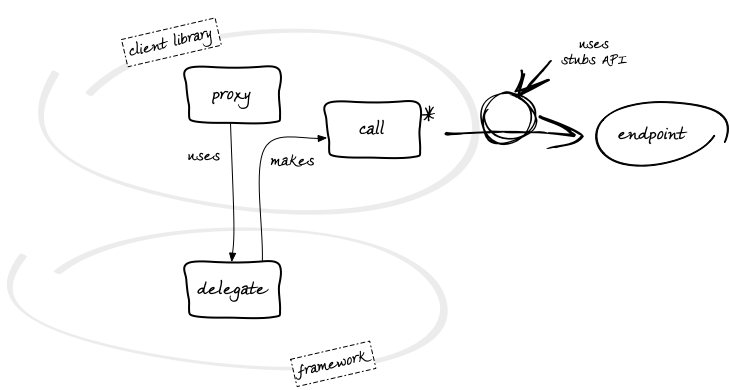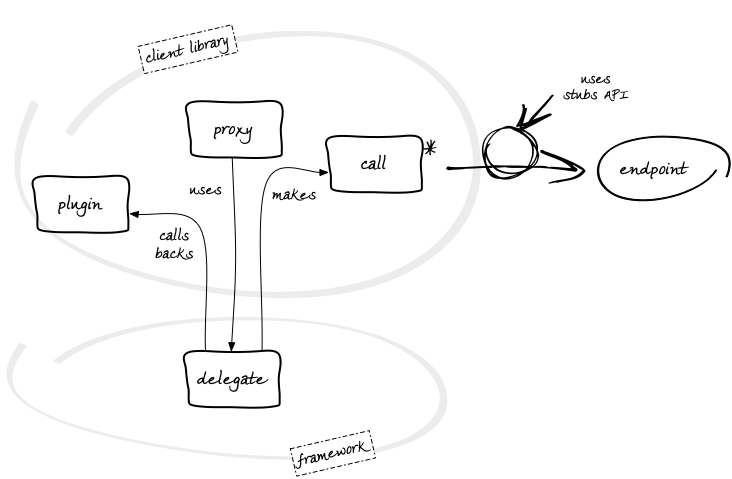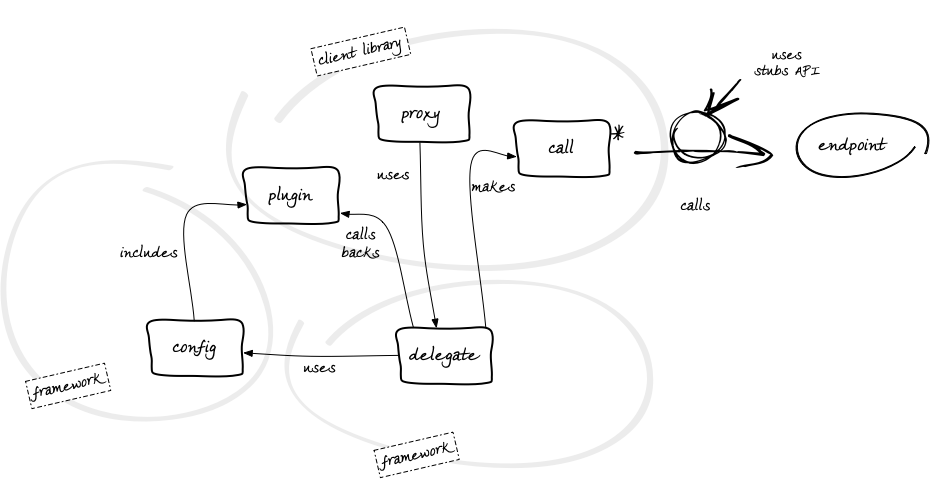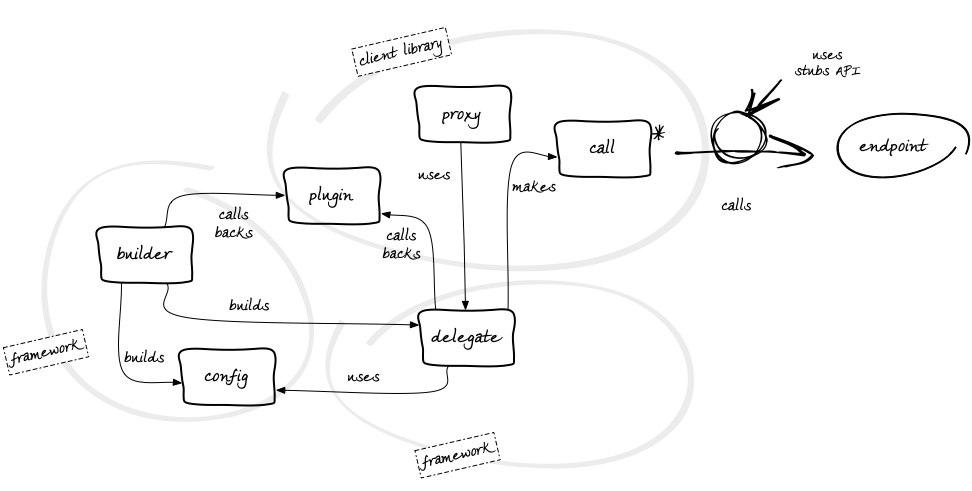Difference between revisions of "Integration and Interoperability Facilities Framework: Client Libraries Framework"
(→Framework Support) |
|||
| Line 123: | Line 123: | ||
<source lang="java5" highlight="3-5"> | <source lang="java5" highlight="3-5"> | ||
| − | Call<FooPortType, | + | Call<FooPortType,String> barCall = new Call<FooPortType,String>() { |
@Override | @Override | ||
public String call(FooPortType endpoint) { | public String call(FooPortType endpoint) { | ||
| Line 131: | Line 131: | ||
</source> | </source> | ||
| − | Delegates make the callback above, providing the required stub instance fully configured with the address of the target service endpoint, the scope associated with the current thread, and any other call-specific information. <code>Foo</code> proxies need not concern themselves with how the delegate discovers and/or binds to endpoints. They can implement their methods uniformly against the delegate. We discuss | + | We discuss <code>Call</code>s in more detail [[#Calls|here]]. |
| + | |||
| + | Delegates make the callback above, providing the required stub instance fully configured with the address of the target service endpoint, the scope associated with the current thread, and any other call-specific information. <code>Foo</code> proxies need not concern themselves with how the delegate discovers and/or binds to endpoints. They can implement their methods uniformly against the delegate. We discuss ProxyDelegate</code>s in more detail [[#Delegates|here]]. | ||
Of course, delegates need to be configured to act on behalf of <code>Foo</code> proxies. The main piece of configuration is a <code>ProxyPlugin</code> object that implements an interface of callback methods. The delegates will consult the plugin to obtain information and services which are specific to theclient library. They will use this information to adapt their binding strategies to <code>foo</code> endpoints. | Of course, delegates need to be configured to act on behalf of <code>Foo</code> proxies. The main piece of configuration is a <code>ProxyPlugin</code> object that implements an interface of callback methods. The delegates will consult the plugin to obtain information and services which are specific to theclient library. They will use this information to adapt their binding strategies to <code>foo</code> endpoints. | ||
Revision as of 14:14, 22 May 2012
gCube includes client libraries for many of its services and defines a general model for their design. The model requires that all libraries offer a common set of capabilities and adopt uniform patterns for the design of their APIs, regardless of service semantics and technology stacks. The model, however, does not indicate how capabilities and patterns should be implemented, nor does it mandate low-level API details.
The client library framework supports the implementation of client libraries which comply with the model. Through code sharing, the framework reduces development costs for client libraries and ensures the consistency and correctness of their implementations.
In this document, we assume familiarity with the design model and illustrate how the framework can be used to develop a model-compliant client library for a hypothetical foo service.
Contents
Distribution
The framework is layered across as a set of components, all of which are available in our Maven repositories as artifacts in the org.gcube.core group.
common-clients is the top layer of the framework and comprises classes and interfaces that do not depend on particular technology stacks. In this sense, common-clients is as general as the design model. Lower layers of the framework adapt common-clients to specific stacks. At the time of writing, gCore is the dominant technology stack for gCube services and their clients. common-gcore-clients is thus the only available specialisation of common-clients.
We assume accordingly that foo is a gCore service, i.e. a JAX-RPC Java service that can be deployed in one or more gCore containers on some gCube hosting nodes. We also assume that the client library for foo is developed as a Maven project, in line with system recommendations. To use the framework, the library declares a compile-time dependency on common-gcore-clients in its POM, as follows:
<dependency> <groupId>org.gcube.core</groupId> <artifactId>common-gcore-clients</artifactId> <version>...</version> <scope>compile</version> </dependency>
This dependency brings common-gcore-clients and its transitive dependencies, including common-clients, on the compile-time classpath of the library. The version will vary over time and is 2.0.0 at the time of writing.
The library depends also on the stub library of foo, which we also assume available as a Maven artifact, e.g.:
<dependency> <groupId>org.gcube.samples</groupId> <artifactId>foo-stubs</artifactId> <version>...</version> <scope>compile</version> </dependency>
Overview
We consider first the requirements that the model raises against client libraries. This illustrates the challenges faced by client libraries to achieve compliance with the model, hence the likelihood of variations in style and quality across their implementations. We then overview the support offered by the framework towards meeting those challenges in a consistent and cost-effective manner.
Implementation Requirements
The design model for client libraries mandates the use of service proxies. The library represents foo with an interface Foo and its default implementation DefaultFoo. Foo defines methods that correspond to the remote operations of foo endpoints, and DefaultFoo implements the methods against the lower-level API of foo stubs.
For example, if FooPortType is the type of foo stubs and bar() one of their String-valued methods, the proxy pattern maps onto code of this form:
public interface Foo { String bar() throws ...; } public class DefaultFoo implements Foo { public String bar() throws ... { ...FooPortType endpoint... try { return endpoint.bar(); } catch(...) { //fault handling } }
In itself, the pattern is straightforward. Some complexity may arises from the design requirements of particular Foo methods, including particular types inputs or outputs (e.g. e.g. streams)), faults with diverse semantics (e.g. outages vs. contingencies), and particular invocation semantics (e.g. asynchronous)). The framework offer limited support here, as the design directives provided by the model do not require it on average. Where they do, the model indicates dedicated gCube libraries that provide it (e.g. the streams library, the scope library, or the security library). The framework does include the classes and interfaces upon which its directives are based, however. We discuss these components and their placement within the framework here.
Arguably, the strongest demand that the model makes on the client library concerns how Foo proxies bind to service endpoints. The requirement is for two binding modes:
- in direct mode, the proxies obtain the address of given service endpoints from clients and execute all their methods against those endpoints;
- in discovery mode, the proxies identify service endpoints from queries to gCube discovery services;
Implementing direct mode is fairly simple, as clients provide all the binding information. They model addresses as W3CEndpointReferences or - depending on wether foo is a stateless or stateful service - as (host, port) pairs or (host, port, key) triples. As stubs APIs for gCore services model addresses as EndpointReferenceTypes, the library is required to implement address conversion and address validation. Though conceptually simple, the task is error-prone and sufficiently boilerplate to call for reuse through the framework.
Implementing discovery mode is significantly more complicated, as the proxies are responsible for using query results in a fault-tolerant and optimised manner. The model requires that the library implements binding and caching strategies which depend on correct handling of a variety of different fault types. Queries must be value objects that hide the lower-level idioms of query formulation and submission required by the gCube discovery services.
Since the two modes are markedly different, combining them in a single proxy implementation presents its own challenges. In particular, it becomes difficult to implement Foo’s methods uniformly, regardless of the binding mode of proxy instances. Lack of homogeneity extends to proxy configuration and threatens the overall testability of the code. Solutions to these problems are likely to vary in style and quality across client libraries.
Framework Support
We now give a tour of the support offered by the framework towards meeting the implementation challenges discussed above. We expand on the role and use of individual framework components in later sections.
The key contribution of the framework comes in the form of ProxyDelegates, i.e. components that know how to make calls in a given mode on behalf of proxies. The idea is that the library defines explicit Call objects and its proxies pass them to the delegates for execution.
With this pattern, Foo proxies can be implemented as follows:
public class DefaultFoo implements Foo { private ProxyDelegate<FooPortType> delegate; public void bar() throws ... { Call<FooPortType,String> barCall = ... try { delegate.make(barCall); } catch(...) { //fault handling } ... }
Call<c/ode>s are anonymous implementations of a simple callback interface:
Call<FooPortType,String> barCall = new Call<FooPortType,String>() { @Override public String call(FooPortType endpoint) { return endpoint.bar(); }}
We discuss <code>Calls in more detail here.
Delegates make the callback above, providing the required stub instance fully configured with the address of the target service endpoint, the scope associated with the current thread, and any other call-specific information. Foo proxies need not concern themselves with how the delegate discovers and/or binds to endpoints. They can implement their methods uniformly against the delegate. We discuss ProxyDelegate</code>s in more detail here.
Of course, delegates need to be configured to act on behalf of Foo proxies. The main piece of configuration is a ProxyPlugin object that implements an interface of callback methods. The delegates will consult the plugin to obtain information and services which are specific to theclient library. They will use this information to adapt their binding strategies to foo endpoints.
public class FooPlugin implements Plugin<FooPortType,Foo> { ... }
ProxyPlugins are thus the main point of interface between the framework and the client library. We discuss their callbacks in detail here.
Besides ProxyPlugins, delegates need configuration specific to the mode in which they are to operate. Delegates that operate in direct mode needs given endpoint addresses, and delegates that operate in discovery mode need queries. Some of the required configuration is provided by Foo clients, other is be provided by the client library.
Building and configuring delegates does not need to fall upon the client library either. The library can use builders provided by the framework instead, a StatelessBuilder if foo is stateless and a StatefulBuilder if foo is stateful. The library needs only to create these builders on behalf of its clients, ideally from a static factory method that can be conveniently imported by clients. Assuming a a stateless foo for example, the library can expose builders as follows:
public class FooProxies { private static final FooPlugin plugin = new FooPlugin(); public static StatelessBuilder<FooPortType,Foo> foo() { return new StatelessBuilder<FooPortType,Foo>(plugin); }}
Here, the library creates builders with its ProxyPlugin. The builders will then:
- gather the required configuration from the clients, using a fluent and statically typed API;
- create and configure a delegate with the
ProxyPlugin<code> and the configuration provided by clients. Different forms of configurations result in delegates that work in direct or in discovery mode;
- collaborate with the <code>ProxyPlugin to give back to clients
Fooproxies configured with the delegate;
For example, library clients may use the StatelessBuilder above as follows:
import static ...FooProxies.*; ... Foo proxy = foo().at(“acme.org”,8080).build();
Since the client is providing the address of a given endpoint here, the builder creates a Foo proxy that uses a delegate which makes calls in direct mode to that endpoint. On the other hand, if the client uses the DSL as follows:
Foo proxy = foo().build();
the builder creates a Foo proxy that uses a delegate which makes calls in discovery mode. Thus clients are fluently driven towards the proxies they need, and the library can implement its proxies ignoring configuration and binding mode issues.
The builders can also gather additional configuration required by the model (e.g. timeouts), as well as configuration which is specific to the client library. We discuss these possibilities in detail here.
If foo is stateful, the DSL of StatefulBuilders makes room for the configuration of instance queries. Again, the framework provides StatefulQuerys for foo instances and the client library needs only to customise the queries and return them to clients. For example:
public class FooProxies { private static final FooPlugin plugin = new FooPlugin(); ... public static StatefulQuery name(String name) { StatefulQuery query = new StatefulQuery(plugin); query.addCondition(“//Name”,name); return query; }}
Here the library exposes queries for service instances that verify a given condition, using XPath to reach within the instance descriptions published within the system. Clients can then embed queries in the DSL of builders, e.g. as follows:
import static ...FooProxies.*; ... Foo proxy = foo().matching(name(“..”)).build();
We discuss queries in more detail here.




